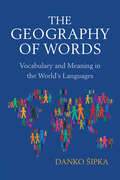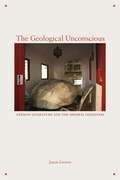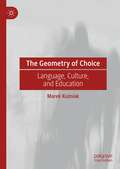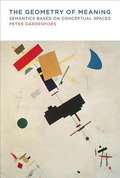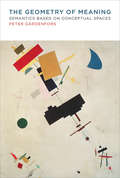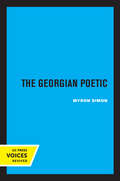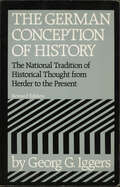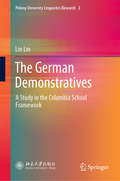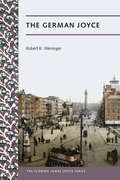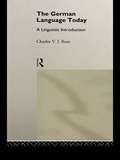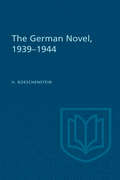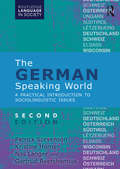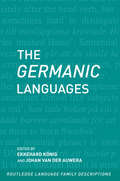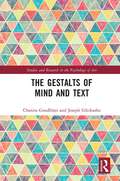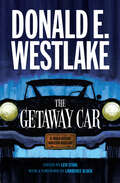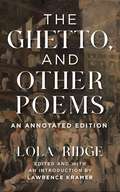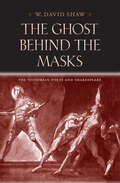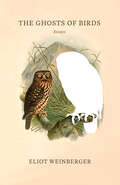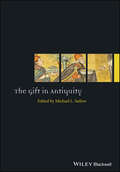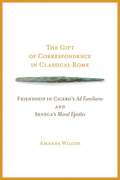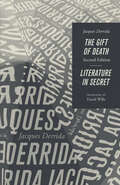- Table View
- List View
The Geography of Words: Vocabulary and Meaning in the World's Languages
by Danko SipkaLanguages around the world organize their lexicons, or vocabularies, in a myriad of different ways. This book is a celebration of global linguistic diversity, bringing together fascinating cases from a wide range of languages to explore how and why this lexical variation occurs. Each of the thirty-six short chapters shows how different culturally-specific words, relating to a range of phenomena such as kinship, colour, space, time, objects, smells, and animals, vary across languages and geographical locations. It also explains the mechanisms of development in vocabularies, showing why this variation occurs, and how languages and cultures interact, to deepen the reader's understanding of one of the most important aspects of linguistics. Assuming little to no prior knowledge of linguistics, and introducing concepts in an accessible way, this book is an entertaining, informative read for anyone who wants to learn more about the incredible variation and diversity of the human lexicon.
The Geological Unconscious: German Literature and the Mineral Imaginary
by Jason GrovesAlready in the nineteenth century, German-language writers were contending with the challenge of imagining and accounting for a planet whose volatility bore little resemblance to the images of the Earth then in circulation. The Geological Unconscious traces the withdrawal of the lithosphere as a reliable setting, unobtrusive backdrop, and stable point of reference for literature written well before the current climate breakdown.Through a series of careful readings of romantic, realist, and modernist works by Tieck, Goethe, Stifter, Benjamin, and Brecht, Groves elaborates a geological unconscious—unthought and sometimes actively repressed geological knowledge—in European literature and environmental thought. This inhuman horizon of reading and interpretation offers a new literary history of the Anthropocene in a period before it was named.These close readings show the entanglement of the human and the lithic in periods well before the geological turn of contemporary cultural studies. In those depictions of human-mineral encounters, the minerality of the human and the minerality of the imagination become apparent. In registering libidinal investments in the lithosphere that extend beyond Carboniferous deposits and beyond any carbon imaginary, The Geological Unconscious points toward alternative relations with, and less destructive mobilizations of, the geologic.
The Geometry of Choice: Language, Culture, and Education
by Marek KuźniakThis book offers a cognitive-semantic insight into the roots of the human decisionmaking process, using the metaphor of CHOICE as CUBE. The areas of key interest are language, culture, and education as forms of social organization. This book addresses issues relevant to a number of fields, including social epistemology, cognitive linguistics, cognitive anthropology, philosophy, culture and education studies, and will be of interest to readers in these and related disciplines.
The Geometry of Meaning
by Peter GärdenforsIn The Geometry of Meaning, Peter Gärdenfors proposes a theory of semantics that bridges cognitive science and linguistics and shows how theories of cognitive processes, in particular concept formation, can be exploited in a general semantic model. He argues that our minds organize the information involved in communicative acts in a format that can be modeled in geometric or topological terms -- in what he terms conceptual spaces, extending the theory he presented in an earlier book by that name. Many semantic theories consider the meanings of words as relatively stable and independent of the communicative context. Gärdenfors focuses instead on how various forms of communication establish a system of meanings that becomes shared between interlocutors. He argues that these "meetings of mind" depend on the underlying geometric structures, and that these structures facilitate language learning. Turning to lexical semantics, Gärdenfors argues that a unified theory of word meaning can be developed by using conceptual spaces. He shows that the meaning of different word classes can be given a cognitive grounding, and offers semantic analyses of nouns, adjectives, verbs, and prepositions. He also presents models of how the meanings of words are composed to form new meanings and of the basic semantic role of sentences. Finally, he considers the future implications of his theory for robot semantics and the Semantic Web.
The Geometry of Meaning: Semantics Based on Conceptual Spaces
by Peter GardenforsA novel cognitive theory of semantics that proposes that the meanings of words can be described in terms of geometric structures. In The Geometry of Meaning, Peter Gärdenfors proposes a theory of semantics that bridges cognitive science and linguistics and shows how theories of cognitive processes, in particular concept formation, can be exploited in a general semantic model. He argues that our minds organize the information involved in communicative acts in a format that can be modeled in geometric or topological terms—in what he terms conceptual spaces, extending the theory he presented in an earlier book by that name. Many semantic theories consider the meanings of words as relatively stable and independent of the communicative context. Gärdenfors focuses instead on how various forms of communication establish a system of meanings that becomes shared between interlocutors. He argues that these “meetings of mind” depend on the underlying geometric structures, and that these structures facilitate language learning. Turning to lexical semantics, Gärdenfors argues that a unified theory of word meaning can be developed by using conceptual spaces. He shows that the meaning of different word classes can be given a cognitive grounding, and offers semantic analyses of nouns, adjectives, verbs, and prepositions. He also presents models of how the meanings of words are composed to form new meanings and of the basic semantic role of sentences. Finally, he considers the future implications of his theory for robot semantics and the Semantic Web.
The Georgian Poetic
by Myron SimonThis title is part of UC Press's Voices Revived program, which commemorates University of California Press’s mission to seek out and cultivate the brightest minds and give them voice, reach, and impact. Drawing on a backlist dating to 1893, Voices Revived makes high-quality, peer-reviewed scholarship accessible once again using print-on-demand technology. This title was originally published in 1975.
The German Conception of History: The National Tradition of Historical Thought from Herder to the Present
by Georg G. IggersThe first comprehensive critical examination in any language of the German national tradition of historiography This is the first comprehensive critical examination in any language of the German national tradition of historiography. It analyzes the basic theoretical assumptions of the German historians of the nineteenth and twentieth centuries and relates these assumptions to political thought and action. The German national tradition of historiography had its beginnings in the reaction against the Enlightenment and the French Revolution of 1789. This historiography rejected the rationalistic theory of natural law as universally valid and held that all human values must be understood within the context of the historical flux. But it maintained at the same time the Lutheran doctrine that existing political institutions had a rational basis in the will of God, though only a few of these historians were unqualified conservatives. Most argued for liberal institutions within the authoritarian state, but considered that constitutional liberties had to be subordinated to foreign policy—a subordination that was to have tragic results. Mr. Iggers first defines Historismus or historicism and analyzes its origins. Then he traces the transformation of German historical thought from Herder's cosmopolitan culture-oriented nationalism to exclusive state-centered nationalism of the War of Liberation and of national unification. He considers the development of historicism in the writings of such thinkers as von Humboldt, Ranke, Dilthey, Max Weber, Troeltsch, and Meinecke; and he discusses the radicalization and ultimate disintegration of the historicist position, showing how its inadequacies contributed to the political débâcle of the Weimar Republic and the rise of National Socialism. No one who wants to fully understand the political development of national Germany can neglect this study.
The German Demonstratives: A Study in the Columbia School Framework (Peking University Linguistics Research #2)
by Lin LinThis book explores, analyzes, and compares the use of German and Chinese demonstratives. Discourse and textual uses of the forms are considered, as well as their locative and temporal uses. The author observes that in both languages the demonstratives can be used to refer to referents. However, she departs from the common assumption that proximal demonstratives refer to entities or places close to the speaker, while non-proximal demonstratives refer to entities or places far from the speaker. Having analyzed a representative sampling consisting of a German text and a Chinese text, the author argues that both German and Chinese proximal demonstratives can signal the meaning of HIGH DEIXIS in a system of DEIXIS in the Columbia School of linguistics framework, whereas their non-proximal demonstratives can signal the meaning of LOW DEIXIS. In addition, Chinese demonstratives can be used under more circumstances than German demonstratives due to the lack of articles in Chinese. The author also argues that Cognitive Linguistic analysis is more helpful for new language learners, whereas the Columbia School of linguistics may be better suited to advanced learners who wish to know more about the intrinsic differences between words with similar meanings and uses.This book aims to help German learners better understand the German reference system. Readers with a Chinese language background will definitely benefit more from the book, as well as Chinese learners with a German language background. For pure linguistic enthusiasts and multi-linguals, the book offers an extensive introduction to the Columbia School of linguistics, and can open a new horizon for learning a new language comparatively.
The German Joyce (Florida James Joyce)
by Robert K. Weninger"The first comprehensive account of the enormous impact of Joyce on German modernist and postmodern writers. An indispensable book on Joyce's 'German' face."—Gerald Gillespie, Stanford University In August 1919, a production of James Joyce's Exiles was mounted at the Munich Schauspielhaus and quickly fell due to harsh criticism. The reception marked the beginning of a dynamic association between Joyce, German-language writers, and literary critics. It is this relationship that Robert Weninger analyzes in The German Joyce. Opening a new dimension of Joycean scholarship, this book provides the premier study of Joyce's impact on German-language literature and literary criticism in the twentieth century. The opening section follows Joyce's linear intrusion from the 1910s to the 1990s by focusing on such prime moments as the first German translation of Ulysses, Joyce's influence on the Marxist Expressionism debate, and the Nazi blacklisting of Joyce's work. Utilizing this historical reception as a narrative backdrop, Weninger then presents Joyce's horizontal diffusion into German culture. Weninger succeeds in illustrating both German readers' great attraction to Joyce's work as well as Joyce's affinity with some of the great German masters, including Goethe and Rilke. He argues that just as Shakespeare was a model of linguistic exuberance for Germans in the eighteenth century, Joyce became the epitome of poetic inspiration in the twentieth. This volume, through Weninger's critiques and repositions, simultaneously revisits the fraught relationship between influence and intertextuality in literary studies and reassesses their value as tools for contemporary comparative criticism today. Robert K. Weninger, emeritus professor of German and comparative literature at King’s College London, is author or editor of over ten books, including Arno Schmidts Joyce-Rezeption 1957-1970: Ein Beitrag zur Poetik Arno Schmidts, and is a past editor of the Journal of Comparative Critical Studies.
The German Language Today: A Linguistic Introduction
by Charles RussThis clear and accessible text provides a complete introduction to basic linguistic terms and descriptions of language structures. The German Language Today describes in detail the main liguistic features of the language and the wide variety of speech forms and vocabulary existing within the German-speaking community. It also introduces sociolinguistic and linguistic topics as they relate to the German language, and illustrates them widely with examples. The German Language Today describes the sounds, inflectional processes, syntactic structures, competing forms and different layers of words in the language. Topics covered include: The distribution of German and its dialects The linguistic consequences of German reunification The application of modern linguistic concepts to German, incorporating the findings of the latest German linguistic research. The book has been written with the specific needs of students in mind. It will be invaluable to students of modern German linguistics or modern German society and will be a useful reference resource for postgraduates and teachers of German.
The German Novel, 1939-1944
by H. BoeschensteinThis book begins the large task of sorting out the vast number of German literary works which the war has piled up before us. The author has culled over four hundred novels and critical works and by indicating the numbers and content of the more significant novels, and some of their stylistic characteristics, he has shortened the task of future research.If this investigation provides a fair indication, it appears that the widely held conviction that German publishers brought out nothing but trash during the war years is mistaken. By now, students of literature should be in a sufficiently intelligent and tolerant mood to accept some detailed evidence and to begin to scrutinize it objectively. The present study is intended as a step in that direction.
The German-Speaking World: A Practical Introduction to Sociolinguistic Issues (Routledge Language In Society Ser.)
by Patrick Stevenson Gertrud Reershemius Kristine Horner Nils LangerThe German-Speaking World is an accessible textbook that offers students the opportunity to explore for themselves a wide range of sociolinguistic issues relating to the German language and its role in the world. This new, second edition has been fully revised to reflect the many political and social changes of the last 20 years including the impact of technology on language change. It continues to combine text with practical exercises and discussion questions to stimulate readers to think for themselves and to tackle specific problems. Key features of this book: Informative and comprehensive: covers a wide range of current issues Practical: contains a variety of graded exercises and tasks plus an index of terms Topical and contemporary: deals with current situations and provides up-to-date illustrative material Thought-provoking: encourages students to reflect and research for themselves The German-Speaking World is the ideal textbook for undergraduate students who have a sound practical knowledge of German but who have little or no knowledge of linguistics or sociolinguistics.
The Germanic Languages (Routledge Language Family Series)
by Ekkehard Konig Johan van der AuweraProvides a unique, up-to-date survey of twelve Germanic languages from English and German to Faroese and Yiddish.
The Gestalt Shift in Conan Doyle's Sherlock Holmes Stories
by Michael J. CroweThis book analyzes the four novels and fifty-six stories written by Sir Arthur Conan Doyle describing the adventures and discoveries of Sherlock Holmes. Michael J. Crowe suggests that nearly all the Holmes stories exhibit the pattern known as a Gestalt shift, in which suddenly Holmes’s efforts reveal a new perspective on the case, typically identifying the culprit(s) and resolving the case. Drawing on ideas presented by Thomas S. Kuhn in his famous Structure of Scientific Revolutions (1962), Crowe argues that similar to the way that Kuhn applied the idea of a Gestalt shift to the history of science, this approach can be used to reveal the structure of the Holmes stories and possibly be applied to some other areas of fiction.
The Gestalts of Mind and Text (Studies and Research in the Psychology of Art)
by Chanita Goodblatt Joseph GlicksohnThe Gestalts of Mind and Text bridges literary studies and cognitive psychology to provide a unique contribution to the field of Cognitive Literary Studies. The book presents an investigation of metaphor in poetic texts, adopting and developing empirical methods used by Gestalt Psychology, while integrating concepts informed by Gestalt Psychology. The title indicates an intellectual tradition, to be termed the Gestalt of the Mind, that begins with the Würzburg School of Psychology and its subsequent development into Gestalt Psychology, which provides a rich heritage for the field of Cognitive Literary Studies. The title further indicates an intellectual and creative tradition, to be termed the Gestalt of the Text, applied to various literary schools (Medieval, Early Modern, Modernist). Finally, the Gestalt-Interaction Theory of Metaphor delineates the potentialities for different types of readings of poetic metaphor. This book further makes three significant contributions: the first is the focus on the empirical investigation of metaphor in poetic texts; the second is the integration of the aspects of problem-solving, bidirectionality of metaphor, embodied cognition and the grotesque, in analyzing poetic texts and verbal protocols; and the third is the focus on various literary traditions, spanning languages and periods. The goal of this book is to present an interdisciplinary study of the Gestalts of Mind and Text. This will be of interest to a varied audience, including cognitive psychologists, literary scholars, researchers in aesthetics, scholars of metaphor and those with an interest in intellectual history.
The Getaway Car: A Donald Westlake Nonfiction Miscellany
by Donald E. Westlake&“This is a book for everyone, anyone who likes mystery novels or good writing or wit and passion and intelligence.&”—The New York Times Over the course of a fifty-year career, Donald E. Westlake published nearly one hundred books, including two long-running series starring the hard-hitting Parker and the hapless John Dortmunder. With The Getaway Car, we get our first glimpse of another side of Westlake the writer: what he did when he wasn&’t busy making stuff up. Mixing previously published pieces, many little seen, with never-before-published material found in Westlake&’s working files, this compendium offers a clear picture of the man behind the books—including his thoughts on his own work and that of his peers, mentors, and influences. It opens with revealing (and funny) fragments from an unpublished autobiography, then goes on to offer an extended history of private eye fiction, a conversation among Westlake&’s numerous pen names, letters to friends and colleagues, interviews, appreciations of fellow writers, and much, much more. There&’s even a recipe for Sloth à la Dortmunder. Really. &“A must-have for Westlake fans.&”—Publishers Weekly (starred review) &“This book doesn&’t disappoint…Westlake was a hugely entertaining and witty writer. Whether he is writing a letter to his editor or about the history of his genre, he remains true to his definition of what makes a great writer: &‘passion, plus craft.&’&”—The Guardian &“[A] valuable collection.&”—Toronto Star Includes a foreword by Lawrence Block
The Getaway Car: A Donald Westlake Nonfiction Miscellany
by Donald Westlake edited by Levi StahlOver the course of a fifty-year career, Donald Westlake published nearly one hundred books, including not one - but two - long-running series, starring the hard-hitting Parker and the hapless John Dortmunder. In the six years since his death, Westlake's reputation has only grown, with fans continuing to marvel at his tightly constructed plots, no-nonsense prose, and keen, even unsettling, insights into human behavior. With The Getaway Car, we get our first glimpse at another side of Westlake the writer: what he did when he wasn't busy making stuff up. And it's fascinating. Setting previously published pieces, many little-seen, alongside never-before-published material found in Westlake's working files, the book offers a clear picture of the man behind the books - including his background, experience, and thoughts on his own work and that of his peers, mentors, and influences. The book opens with revealing (and funny) fragments from an unpublished autobiography, then goes on to offer an extended history of private eye fiction, a conversation among Westlake's numerous pen names, letters to friends and colleagues, interviews, appreciations of fellow writers, and much, much more. There's even a recipe for Sloth a la Dortmunder. Really. Rounded out with a Foreword by Westlake's longtime friend Lawrence Block, The Getaway Car is a fitting capstone to a storied career, and a wonderful opportunity to revel anew in the voice and sensibility of a master craftsman.
The Ghetto, and Other Poems: An Annotated Edition
by Lola RidgeAt last recovered in this enriching annotated edition, this important but neglected work of American modernism offers a unique poetic encounter with the Jewish communities in New York’s Lower East Side.Long forgotten on account of her gender and left-wing politics, Lola Ridge is finally being rediscovered and read alongside such celebrated contemporaries as Hart Crane, William Carlos Williams, and Marianne Moore—all of whom knew her and admired her work. In her time Ridge was considered one of America’s leading poets, but after her death in 1941 she and her work effectively disappeared for the next seventy-five years. Her book The Ghetto and Other Poems, is a key work of American modernism, yet it has long, and unjustly, been neglected. When it was first published in 1918—in an abbreviated version in The New Republic, then in full by B. W. Huebsch five months later—The Ghetto and Other Poems was a literary sensation. The poet Alfred Kreymbourg, in a Poetry Magazine review, praised “The Ghetto” for its “sheer passion, deadly accuracy of versatile images, beauty, richness, and incisiveness of epithet, unfolding of adventures, portraiture of emotion and thought, pageantry of pushcarts—the whole lifting, falling, stumbling, mounting to a broad, symphonic rhythm.” Louis Untermeyer, writing in The New York Evening Post, found “The Ghetto” “at once personal in its piercing sympathy and epical in its sweep. It is studded with images that are surprising and yet never strained or irrelevant; it glows with a color that is barbaric, exotic, and as local as Grand Street.”The long title poem is a detailed and sympathetic account of life in the Jewish Ghetto of New York’s Lower East Side, with particular emphasis on the struggles and resilience of women. The subsequent section, “Manhattan Lights,” delves further into city life and immigrant experience, illuminating life in the Bowery. Other poems stem from Ridge’s lifelong support of the American labor movement, and from her own experience as an immigrant. This critical edition seeks to recover the attention The Ghetto, and Other Poems, and in particular the title poem, lost after Ridge’s death. The poems in the volume are as aesthetically strong as they are historically revealing. Their language combines strength and directness with startling metaphors, and their form embraces both panoramic sweep and lyrical intensity. Expertly edited and annotated by Lawrence Kramer, this first modern edition to reproduce the full 1918 publication of The Ghetto and Other Stories offers all the background and context needed for a rich, informed reading of Lola Ridge’s masterpiece.
The Ghost behind the Masks: The Victorian Poets and Shakespeare (Victorian Literature and Culture Series)
by W. David ShawIn The Ghost behind the Masks, W. David Shaw traces Shakespeare’s influence on nine Victorian poets: Alfred Lord Tennyson, Robert Browning, Christina Rossetti, Thomas Hardy, Matthew Arnold, Gerard Manley Hopkins, Algernon Swinburne, Arthur Hugh Clough, and George Meredith. Often, he writes, the transparency of Shakespeare's influence on Victorian poets and the degree of their engagement with Shakespeare exist in inverse ratio. Instead of imitating a play by Shakespeare or merely quoting his lines, a Victorian poet may embrace more elusive elements of rhetoric and style, adapting them to his or her own ends. Shaw argues that the most Shakespearean attribute of the Victorian poets is not their addiction to any particular trope or figure of speech but their reticence, the classical restraint of their great monologues, and their sudden descent from grandeur to simplicity. He explores such topics as man-made law versus natural right, Stoic fatalism versus self-reliance, and the sanity of lunatics, lovers, and poets versus the madness of commonplace minds.
The Ghosts of Birds
by Eliot WeinbergerA new collection from "one of the world's great essayists" (The New York Times) The Ghosts of Birds offers thirty-five essays by Eliot Weinberger: the first section of the book continues his linked serial-essay, An Elemental Thing, which pulls the reader into "a vortex for the entire universe" (Boston Review). Here, Weinberger chronicles a nineteenth-century journey down the Colorado River, records the dreams of people named Chang, and shares other factually verifiable discoveries that seem too fabulous to possibly be true. The second section collects Weinberger's essays on a wide range of subjects--some of which have been published in Harper's, New York Review of Books, and London Review of Books--including his notorious review of George W. Bush's memoir Decision Points and writings about Mongolian art and poetry, different versions of the Buddha, American Indophilia ("There is a line, however jagged, from pseudo-Hinduism to Malcolm X"), Béla Balázs, Herbert Read, and Charles Reznikoff. This collection proves once again that Weinberger is "one of the bravest and sharpest minds in the United States" (Javier Marías).
The Giant Ohl and Tiny Tim
by Christian BärmannBorn in Würzburg to a poor baker’s family, he was trained at a young age to become a tailor because he was never successful at school. However, he rebelled against his family and went to Hamburg where he began working on ships and travelled to South America a few times. During his teenage years he returned to Würzburg, where his mother encouraged him to become an architect. With his mother’s help, he mustered enough money to attend a school for architecture and art in Munich. Once there, his instructors recognized his great talent for painting and illustration. By the beginning of the twentieth century he served as an apprentice for various painters in Munich and became known not only for his fairy-tale like paintings but also for realistic paintings of Würzburg. He won many prizes for his early work including the Rome Prize, which enabled him to travel to Italy to study the great Italian painters and improve his techniques and understanding of art. He returned to Germany in 1910 and spent a good deal of his time studying animals and nature. He had a special fondness for illustrating frogs, rabbits, and insects. This was one of the reasons Waldemar Bönsels asked him to contribute 60 illustrations to his famous children’s book, Die Biene Maja (Maja the Bee, 1912). Bärmann was greatly disturbed by World War I, and his paintings such as The Revolution (1914) and Der Brand (The Fire, 1914) reflect his concern about the violence in Europe. At the same time, he began to turn to sketching and painting scenes that would illustrate his books for children. Bärmann had a wry sense of humor that can be seen in a series of fairy tales he created from 1914 until his death in 1924: Die Kröte Rockröck (The Frog Röckkröck, 1918), Der Riese Ohl und das Hannesle (The Giant Ohl and Tiny Tim, 1918), and Die Honriche (The Flower Angels, 1923). Bärmann was greatly infatuated if not obsessed by giants and large creatures, who were kind and misunderstood. His compassion for these gigantic people and animals is evident in his paintings and illustrations. In the case of The Giant Ohl, it is clear that the good-natured giant is a friend of humans who have prejudices against strangers, especially when they seem to be enormous dangerous aliens. Bärmann was an unusual painter/storyteller. His texts and images reveal both his serious critique of social prejudice and also his jovial and optimistic perspective on how people might overcome aggressive behavior toward "freaks." Aside from his own work, Bärmann also produced illustrations for Eduard Mörike’s fairy tale Das Märchen vom sicherern Mann (The Fairy Tale about the Man with Confidence, 1907) and Gustav Meyrink’s Golem (1915).
The Gift
by Alain Serge DzotapWhen Leo opens his birthday presents, he receives an amazing gift: a pen! Inside it, Papa says, are many beautiful things. But how do you get them out? None of his friends can guess. Super-Zombo doesn&’t get anywhere by blowing on it, and Coco-Tembo thinks it&’s too tiny to hold anything important. Maybe Leo&’s mama will know how to reveal all the wonders inside… This warm, charming story is a perfect introduction to the joy of writing. Like Leo, young readers will discover how a simple utensil can express all the words in the world—even one&’s own name.
The Gift in Antiquity (Ancient World: Comparative Histories #16)
by Michael L. SatlowThe Gift in Antiquity presents a collection of 14 original essays that apply French sociologist Marcel Mauss’s notion of gift-giving to the study of antiquity. • Features a collection of original essays that cover such wide-ranging topics as vows in the Hebrew Bible; ancient Greek wedding gifts; Hellenistic civic practices; Latin literature; Roman and Jewish burial practices; and Jewish and Christian religious gifts • Organizes essays around theoretical concerns rather than chronologically • Generates unique insights into gift-giving and reciprocity in antiquity • Takes an explicitly cross-cultural approach to the study of ancient history
The Gift of Correspondence in Classical Rome
by Amanda WilcoxAmanda Wilcox offers an innovative approach to two major collections of Roman letters—Cicero’sAd Familiaresand Seneca’sMoral Epistles—informed by modern cross-cultural theories of gift-giving. By viewing letters and the practice of correspondence as a species of gift exchange, Wilcox provides a nuanced analysis of neglected and misunderstood aspects of Roman epistolary rhetoric and the social dynamics of friendship in Cicero’s correspondence. Turning to Seneca, she shows that he both inherited and reacted against Cicero’s euphemistic rhetoric and social practices, and she analyzes how Seneca transformed the rhetoric of his own letters from an instrument of social negotiation into an idiom for ethical philosophy and self-reflection. Though Cicero and Seneca are often viewed as a study in contrasts, Wilcox extensively compares their letters, underscoring Cicero’s significant influence on Seneca as a prose stylist, philosopher, and public figure.
The Gift of Death, Second Edition & Literature in Secret (Religion And Postmodernism Ser.)
by Jacques Derrida“An important contribution to the critical study of ethics . . . [for those] made curious by the controversy that . . . attends Derrida.” —Booklist, on the first editionThe Gift of Death, Jacques Derrida’s most sustained consideration of religion, explores questions first introduced in his book Given Time about the limits of the rational and responsible that one reaches in granting or accepting death, whether by sacrifice, murder, execution, or suicide. Derrida analyzes Czech philosopher Jan Patocka’s Heretical Essays in the Philosophy of History and develops and compares his ideas to the works of Heidegger, Lévinas, and Kierkegaard. One of Derrida’s major works, The Gift of Death resonates with much of his earlier writing, and this highly anticipated second edition is greatly enhanced by David Wills’s updated translation. This new edition also features the first-ever English translation of Derrida’s Literature in Secret. In it, Derrida continues his discussion of the sacrifice of Isaac, which leads to bracing meditations on secrecy, forgiveness, literature, and democracy. He also offers a reading of Kafka’s Letter to His Father and uses the story of the flood in Genesis as an embarkation point for a consideration of divine sovereignty.
